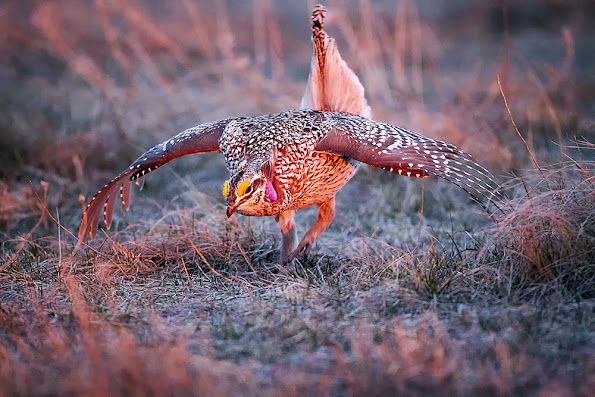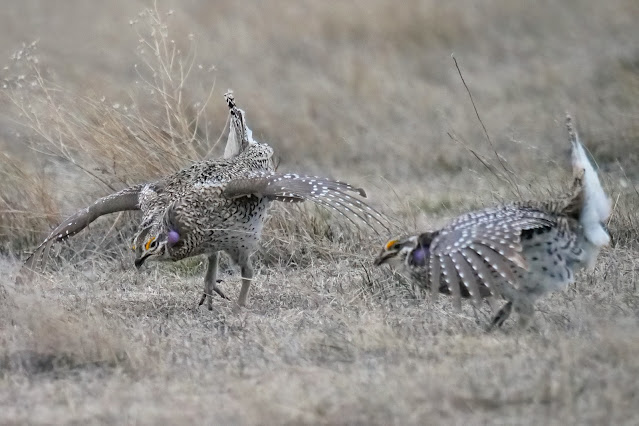Photographing Sharpies at a Lek
Originally I was going to share my thoughts on photographing multiple species of grouse while on their lek but once I started compiling notes (and images) I thought better of it and decided to write about one species at a time and in this post it will be the sharp-tailed grouse, aka "sharpies" or known by the acronym STG.
After photographing STG on a couple leks during our 2022 adventure, I can say they are not the highest jumpers. What does that mean? Compared to the greater and lesser prairie chickens, the chickens win. Their fights reached further off the ground and seem to explode in the air high enough to clear most grasses that play havoc with your camera's Auto Focus abilities.
(Overcast light, ISO 4000, f4, 1/4000, male STG approaching another male, slight crop)Photographing any and all grouse species takes a lot of concentration. Studying behavior at the lek, knowing who the top male is and identifying the female birds is imperative. Once you can recognize where the action is going to take place you will begin to get better images. Plan to visit the same lek more than once to maximize your chances.
Don't shoot too tight. When the action happens, it happens fast. If you are shooting too tight one or more of the birds may exit the frame making it easy to clip wings, heads, etc. At most leks I found my 500mm to be adequate. I also brought a shorter zoom and wider lens to document the entire lek and video the action. I chose to photograph subjects typically between 30' to 200' away although birds came closer at times and many stayed farther out.
More about finding a lek HERE.
Remember to shoot the big picture as well as action and smaller details. I prepared a shot list from research I had done PRIOR to our trip. That list expanded once I better understood grouse behavior and lek conditions (as do most shot lists I start with). I added items to my shot list such as details from the lek AFTER the birds left for the morning. Tell the entire story if you have the chance.
More about ethical wildlife photography HERE.
Practice ethical behavior when photographing all wildlife. Keep your distance. Use a designated blind to hide your presence. There is no good reason to disturb your subject.
Once on a STG lek, find a spot where the birds have stomped down the grasses and hope it's the place they like best and will return time and again. It won't always be, but if it is, you'll have a better chance of avoiding those pesky grass stems throwing off your focus!
(Full sun, ISO 1250, f8, 1/4000, the chase, 50% crop)One of the best pieces of advise we received was to wait for the light. If you are going to shoot early then be creative with motion blur techniques. High ISO's are a must if you plan to stop action. As camera ISO capabilities improve so will your chances of stopping the action early. However, that golden morning sun is really beautiful once it washes over your subject(s) and in my opinion is worth the wait.
Shutter speeds of 1/3200 or higher are needed to freeze wing movement as in any bird in flight / action photography. Of course you will want to get portrait shots along with dance posture, mating and environmental scenes but I always have my shutter speed high for when interaction between the birds begin. Do your best to capture it. Your time on a lek could end at any moment. A passing coyote, low flying raptor or a simple cough could be enough to end the morning photo shoot. Stay quiet in your blind (or in some cases vehicle). At times my camera shutter was loud enough to see a physical reaction from the birds but they never flew away.
Preferred photographic position of grouse during breeding season is different for each species. For a male STG during courtship display a likely position is the dance when the birds wings spread out, their heads bowed close to the ground, their tail fanned out reaching to the sky and their purple skin patches visible on the neck. One of the least attractive positions to capture is a bird flying away from you although in the right light you may just be successful!
Find out more about grouse breeding season HERE.
If you have multiple subjects in the frame adjust your f-stop (aperture) appropriately to capture them in focus. This will often happen when photographing fights, males displaying near a female and in many other scenarios. Stay aware of your settings and check them often.
Hopefully I have presented pertinent information to help enhance your photographic experience on a STG lek during mating season. To sum it up, be prepared for action, interaction and the unexpected! Best of luck next season.
We encourage you to leave a comment and share our blog with family, friends, and on social media.







Comments
Post a Comment